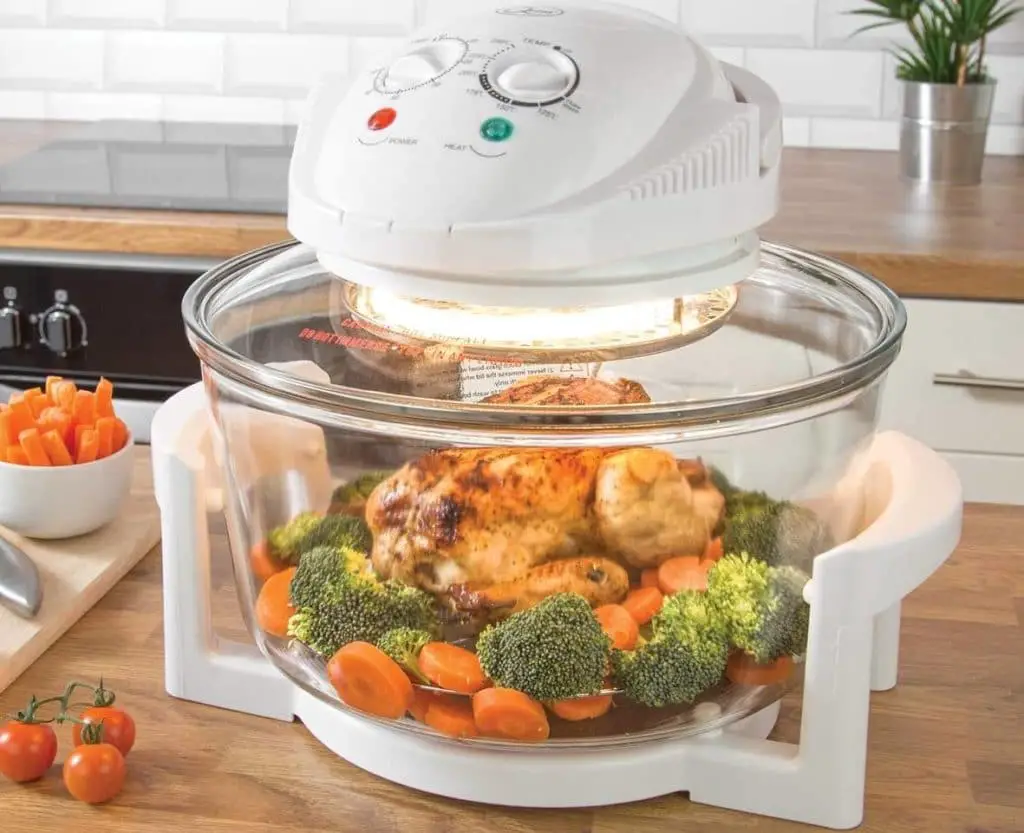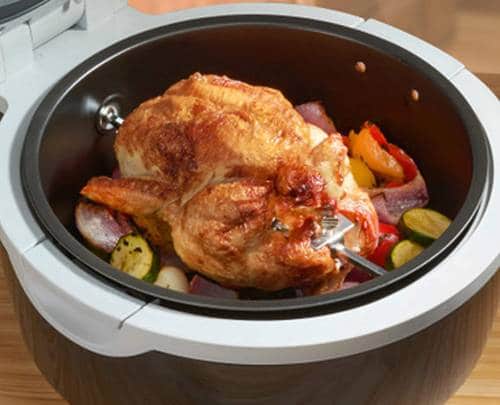Last Updated on
Halogen ovens are fantastic devices that can greatly improve cooking times. These simple appliances cook food using a halogen lamp and an air fan that circulates the heat evenly throughout the cooking bowl. If you want an alternative method of cooking to conventional ovens, a halogen oven could be a fantastic choice.
If you have ever wondered exactly how does a halogen oven work, you are in the right place. In this article, we will answer all of your questions and provide a host of useful information relating to the technology behind it. You will also learn the benefits of these ovens, what you can cook in them, and what to look for when buying one. After reading this guide you should be a halogen oven expert.
The Technology Behind a Halogen Oven
First, let’s take a look at how halogen ovens work so you can see how they differ from standard ovens. There are many types of “standard” ovens – gas, electric, and microwave ovens, for example. These all have a heating element such as a gas flame, an electric heating element, or radio waves.
A halogen oven utilises the same principle. However, it uses a different source for the cooking process. The heating source is a halogen lamp. Halogen bulbs provide the heat and there is usually a fan that circulates the heat evenly throughout the heating chamber for even cooking.
Halogen ovens usually have the following features:

- A halogen lamp for the cooking process
- A fan to circulate the heat and aid the cooking
- A large glass bowl or durable bowl in which food is placed
- Metal cooking racks to support the food
- A top control panel with temperature controls
They are relatively simple devices and easy to use once you understand the controls. Advanced models may also feature drip-trays underneath the main glass bowl to collect any fat and juices from cooking. Also, some models may feature a self-cleaning mechanism that efficiently cleans the bowl.
What Can You Cook in a Halogen Oven?
Now that you understand the technology behind this kitchen appliance, what can you use it for? This is one of the main benefits of this type of oven – you can essentially cook anything that you would in a standard oven. It performs the exact same function, however, it simply uses different cooking methods.
Pro-Tip – If you can cook it in an oven, you can also cook it in a halogen oven!
These are versatile devices that allow you to cook a range of recipes quickly. The following are some examples of foods you can cook in a halogen oven:
- Full chickens
- Beef, pork, and lamb joints
- Jacket potatoes
- Burgers
- Pizzas
- Chips
- Frozen foods
Because of the temperature range that these ovens have, they’re really quite versatile. Halogen ovens can even be used for cooking puddings such as sponges and shortbread. They are also perfect for reheating meals that have already been cooked.
Pro-Tip – Whenever re-heating foods, regardless of the method used, ensure that the food items are safe to re-heat.
People who use this type of oven essentially gain a second oven that they can use to cook full meals. It can also be used for steaming, although it may not be suitable for slow cooking.
What Are the Benefits of Using a Halogen Oven?
As you can see, a halogen convection oven is a versatile device that anyone could benefit from. However, what are the advantages it provides? And why would you buy one instead of a traditional gas or electric oven? The following are some of the main benefits:
Cooking Speed
Firstly, halogen ovens offer much faster cooking. The halogen gas within the heating element is an effective method and provides a powerful, concentrated heat source. Coupled with the fan system that distributes heat and you have a quick-cooking solution that also cooks evenly.
As a minimum, you can expect a 20% improvement in cooking speeds. Also, some ovens can reduce cooking by up to 60% compared to traditional ones. This is perfect for people who have busy schedules and may not always have time to spend hours cooking meals.

Energy Usage
Building on the previous point, as a result of the improved cooking speed, these ovens also use less electricity. The halogen bulb does require more energy. However as the cooking time is lesser, the overall power usage is more minimal compared to a standard gas, electric, or microwave oven.
Easy to Use and Clean
This type of oven is generally easy to use and maintain. Most ovens have a timer and control panel on the top. This usually includes temperature control. All you have to do is set the timer and temperature and place your food in the halogen bowl! For cleaning, you usually have to clean the bowl and any drip trays that capture fat. There is much less surface area to clean than a standard oven.
Space
Finally, this type of device uses lesser counter space and storage. If you have a small kitchen, you may not have space for a large oven. A halogen oven can easily fit in a kitchen cupboard. Alternatively, you can keep it on your kitchen work surface without taking up too much space. Some households even use it as a secondary oven to use for larger family meals or gatherings.
What Should You Look for When Choosing a Halogen Oven?
Finally, let’s look at how you can choose a suitable halogen oven. The design and style of this type of cooker don’t vary much. However, there are important factors that will affect your choice:
Dimensions and Weight
Firstly, you must make sure that you have enough space for this cooker. One of the main halogen oven disadvantages would be that they are not huge. However, you will require a decent amount of cupboard space or work surface space. Review the size and consider where you could store it. Typically, this type of cooker is approximately 40x40x30cm, to give you a rough idea of how much space you need. Think about how much food you cook on a regular basis and what size of oven you will need.
Also, although these devices are not huge, they can be heavy. For example, some halogen devices can weigh up to 10kg including the lid. Ensure that you are comfortable lifting the weight and that you will not cause any injury.
Cooking Power
Next, consider the cooking power and cooking methods. These devices typically have an energy rating of around 1300W. This denotes the power of the bulb and its energy output. The energy output will directly affect the cooking speed. For example, a 1300W device would cook food quicker than a 900W device.
You should also look at the temperature control. Does the device have a temperature dial so you can easily cook different food? Does it support any functions like charcoal grilling, steaming, or slow cooking? Is there a timer so you can use recipe books and cook your food to perfection? Also, consider if you can safely add water to the device during cooking.

Cleaning
As mentioned, cleaning is relatively simple for these devices. However, you should still consider the different parts the device has such as lid stands, a lid, and drip trays. Generally, the bowl is the easiest to clean as you can simply soak it in warm soapy water.
Other items like the support posts or food stand can be more difficult to clean. The stand and trays are placed so that fat and grime can accumulate. Hence, these may require more effort to clean. Generally, the lid should not require cleaning, only the occasional wipe.
Some of these devices even have a self-cleaning function. If you live a busy life, buying an oven with such a feature could be a great time saver.
Food Capacity
Finally, what food capacity does the oven have? Typically, the capacity is specified in litres. This denotes the capacity of the main food bowl. Smaller ovens have a cooking capacity of 10 to 12 litres, whereas you can also buy larger models that have a capacity of 17 litres or more. What capacity you want depends on the types of food you intend to cook, and how many people you typically cook for.
There are also ways to increase the capacity by buying extension rings which could be a good option if you need to cook food for larger groups.
Halogen Oven FAQ
To help you make the most out of this amazing cooker, we’ve answered a few queries below.
Do halogen ovens use a lot of electricity?
The heating element does require a lot of electricity compared to a conventional oven. However, the cooking time is much less which overall reduces the amount of electricity required compared to a standard oven.
How much quicker does a halogen oven cook than a conventional oven?
This varies depending on the model and the manufacturer. Typically, you can expect a cooking speed increase of at least 20%. Some halogen ovens can even cook 40-60% faster than a traditional oven.
Are halogen ovens difficult to clean?
In most instances – no. Generally, you can clean the main cooking bowl simply by adding warm soapy water. Some even have a self-cleaning function.
What Next?
For those who are still wondering how does a halogen oven work, you can watch the video provided above to settle any more lingering questions. However, we think our guide has covered all the most important questions. Many halogen ovens will come with an information booklet for more specific details on your oven, as makes and model may vary slightly.
Paul is the type of person who never met a problem he couldn’t fix. He can always be found tinkering with something in his house, even if it isn’t broken! His tips and tricks are often shared on our site. He’s the one you call when something breaks because he has been known to improvise fixes for everything from leaky faucets to malfunctioning dryers.

I have been using a Halogen oven for several years and find it fantastic as an older couple Living in a flat with no Gas it is also very economical. The biggest problem is once the Halogen bulb goes it’s very difficult to replace it’s a massive design flaw. I really wish I could replace the top or bulb instead I know have two spare bottom bits and pay for a whole new oven